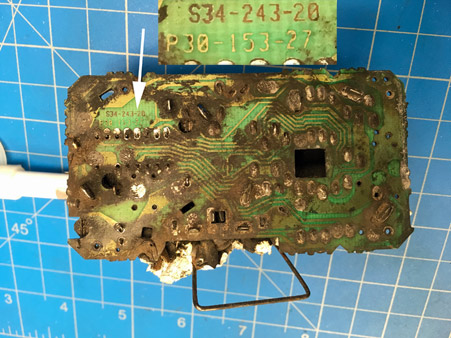When a fire attacks and consumes the plastic body and combustible materials of a smoke alarm, the non-combustible components can be used to identify it. The non-combustible metal components of a smoke alarm include: the bracket that holds the radioacitve source, the top and bottom ionization collector plates, the horn piezoelectric disc, and other metal components. The shape and dimensions of the metal components can be compared to those in known exemplar smoke alarms. Often the manufacturer and the approximate age of a smoke alarm can be determine from just the metal components. BRK etches or stamps numbers in thier metal components. BRK's pieolectric discs have a v-shaped notch in them. Older BRK smoke alarms use spot welds to connect both the top and bottom collector plates to the other electronic components. Newer BRK smoke alarms have a unique spring metal clip between the battery and printed circuit board.
Numbers are stamped into the metal components of smoke alarms. They can be used to identify a manufacture and the relative age of a smoke alarm.




Printed Circuit Boards (PCBs) in smoke alarms are made of fire-retardant material. The shape and dimensions of the unknown smoke alarm PCB can be compared to those of known smoke alarms. To confirm that the PCBs are the same, the copper traces on the PCBs should be compared. If the PCB is covered by melted plastic, then it should be x-rayed.
In the case below (#17-044), Dr. Franco was not only able to determine the model number of the smoke alarm, he was able to closely determine its age from exemplars.
At a joint laboratory examination, the smoke alarm PCB was cleaned up so that the revision and lot numbers could be read. Dr. Franco purchased 8 exemplar smoke alarms from eBay. The revision and lot numbers only matched one of the exemplars. Dr. Franco was able to determine that the smoke alarm around 24 years old. It was still in use at the time of the fire.


The bodies of smoke alarms are plastic that can melt and re-solidify. It is not unusual to have to x-ray smoke alarms to identify them.
In the case below (#16-055), the manufacturer and model number was obtained from the back of the smoke alarm, but it was too badly damaged to determine the date it was manufactured. Eight exemplars were purchased from eBay. Dr. Franco used the UL issue number to narrow the date down to 2 years. This fire was in August 2016, and BRK stopped manufacturering this model in September 2004. Hence, it was over 10 years old and out of date.